A Deep Dive on Trevor Foley’s Aerobars
Editor’s Note: This article is by VeloVetta founder Ed O’Malley.
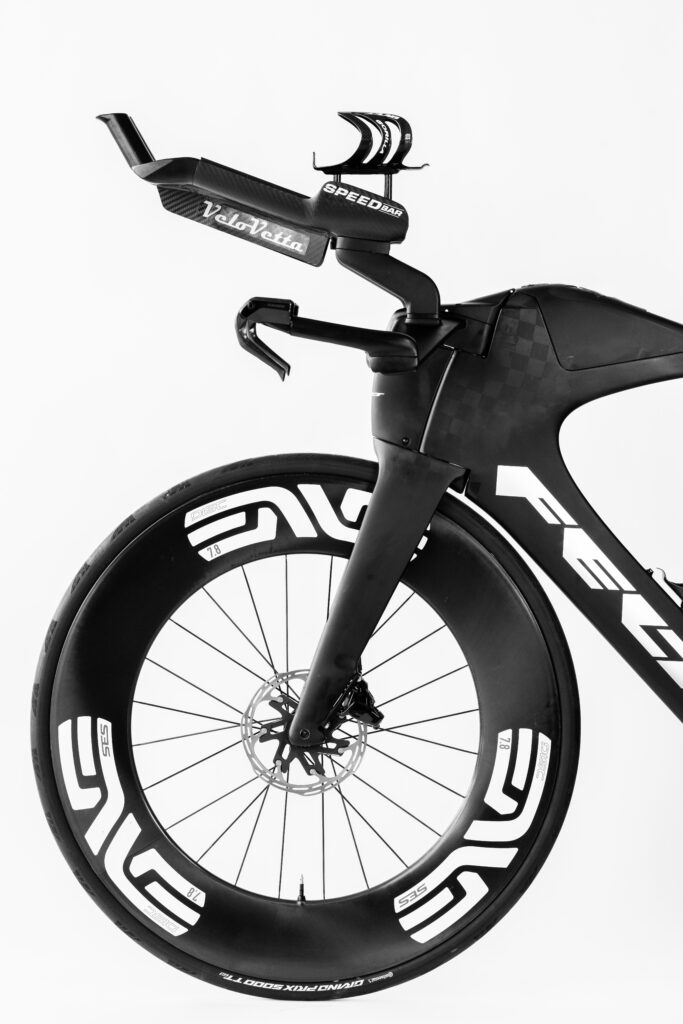
Earlier this year I was approached about working on a collaborative project to improve the aerodynamics of triathlon cockpits between VeloVetta – my company known for making aerodynamic cycling shoes, Edwin of SpeedBar – a manufacturer of high-end aero extensions for triathlon and time trial bikes, and professional triathlete Trevor Foley, all coordinated by Nick of Wove, a manufacturer of bike saddles.
Front-end aerodynamics can be highly affected by not just the choice of aerobar, but also if and how you add a water bottle to it, how it interacts with your particular bike position, and a host of other factors. Add in a raft of new rules from World Triathlon and Ironman about water bottles attached to aerobars, putting together a system that is going to a) be aerodynamically slippery, b) meet your hydration and nutritional needs, and c) fit into ever more complicated rules gets more difficult. It seemed like a good time to see if there was any way to simplify things. Specifically, could we make a set of aerobars that were fast whether or not you had bottles mounted?
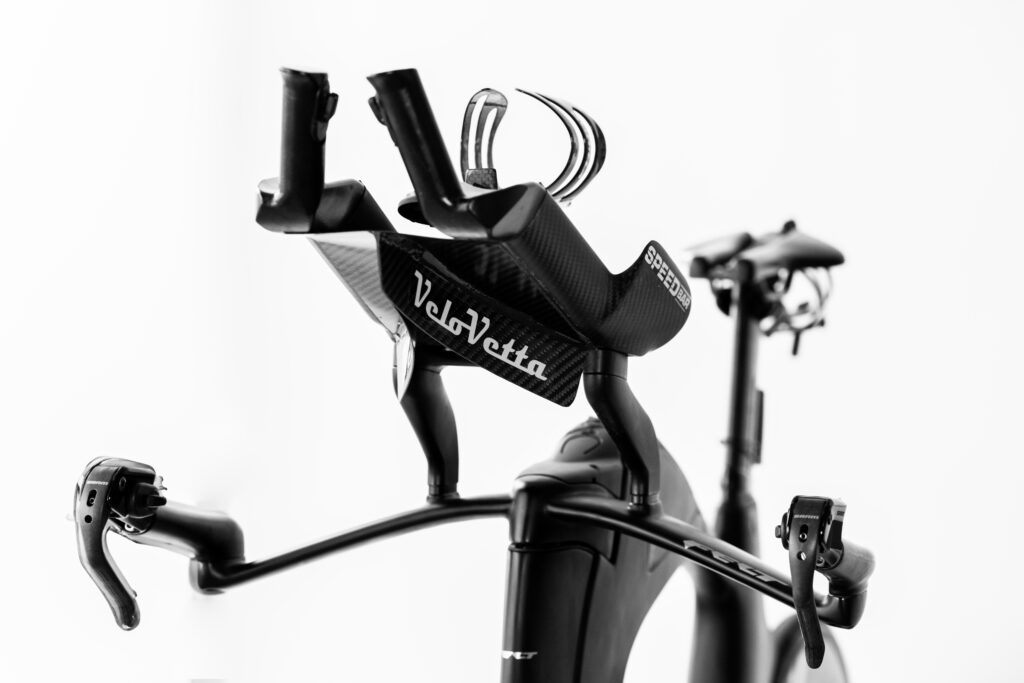
The SpeedBar extensions are already really fast. That is why they are used by pro tour teams like Lidl Trek, Quickstep and Cofidis as well as triathletes like Trevor Foley and Rudy von Berg. Edwin of SpeedBar recently updated his SpeedBar Pro with a new ultra lightweight model that saves 260g from the standard Pro model he introduced in 2024, bringing the total system weight with computer and BTA bottle mounts to 400-500g, depending on extension length. This needs-to-be-held-to-be-believed lightweight model uses an aero-grade alloy mix for the hand grips and a precise carbon layup in the extensions that are ultra thin, yet very strong.
In triathlon there is a wider variety of ways aero extensions may interact with the rest of the bike setup and just because a set of bars are fast on their own doesn’t necessarily mean they are fast in all possible setups. In fact, there are so many variations of setups it would be impossible to test and design for all of them. But if we could ensure that a bar tests fast both with and without a BTA water bottle, that would go a long way towards giving us confidence that it’s going to be fast in most situations.
I used extensive Computational Fluid Dynamics (CFD) modelling to design our shoes at VeloVetta. My background is in mechanical engineering and I have experience working in aerospace as a contractor to NASA as well as in the engine and powertrain industry. CFD is essentially a computerized wind tunnel, but it gives us a lot more information than what you can get from a tunnel. For instance, it shows us in detail how the air puts pressure on all surfaces, and from the geometry of those surfaces you can calculate things like drag, lift and thrust. You can see exactly how the interaction of the air with the objects in the test changes the speed and direction of the wind and how that might change the way it interacts with things further downwind.
We started the project by making a computerized version of Trevor Foley, matching his dimensions and bike position. We left out the bike and lower legs to lower the time required for the computer to run the simulations without affecting the results that we cared about. We then added in a computerized version of the standard SpeedBar design and put this into our virtual wind tunnel to get a baseline for the drag of this setup. We also tested the same setup with a water bottle added in the location that Trevor frequently uses in racing.
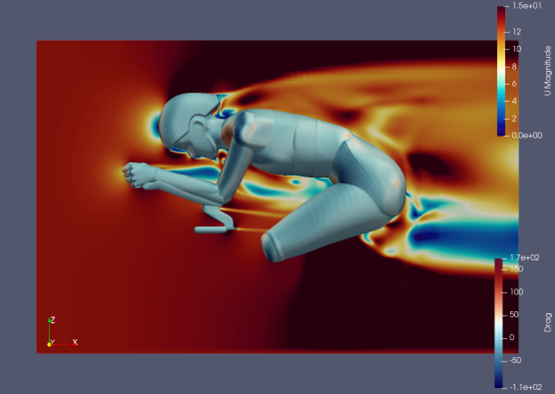
The results showed that adding the water bottle added 61 grams of drag. So we made two more designs, testing them both with and without water bottles. One design connected the aero extensions with a flat carbon plate turning them into a single “monocoque” system. The other design modified the monocoque system with a “strake” that helps with two things: It provides some structural integrity to the otherwise somewhat flimsy carbon connecting plate, potentially eliminating the need for a metal connecting bar between the extensions, and it manages the direction of the airflow downstream of the bar.
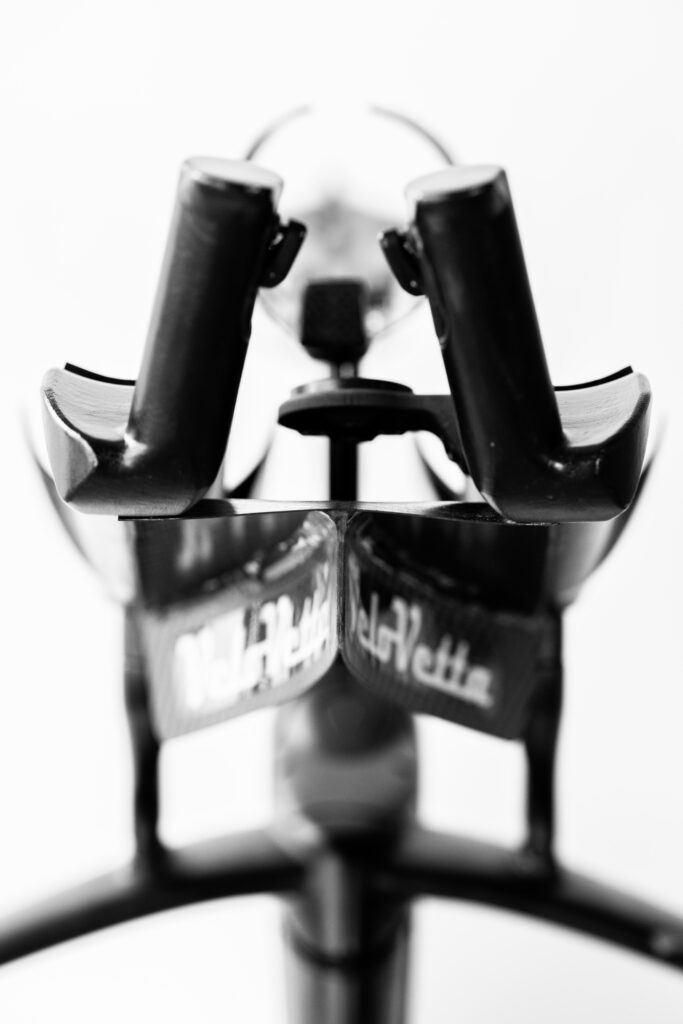
I hear a lot of people make the assumption that the mono aero extension designs are obviously faster than two separate bars, but our results along with results shared with us by Edwin, Marc Graveline and others show that is not necessarily the case. Our mono bar tested slower than the standard SpeedBar when it does not have a water bottle attached. But adding the water bottle helped bring down the drag to be even faster than the SpeedBars alone.
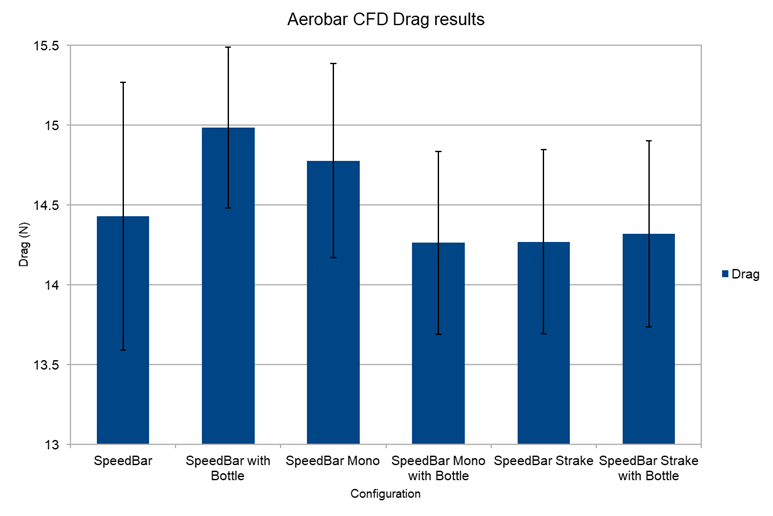
With this design the mono bar is faster with the water bottle, but if you get rid of that bottle mid-race, you have negatively affected your aerodynamics. The design utilizing the strake resulted in drag that was fast with or without the bottle in place. Analysis of streamlines (visualizations of the path that certain bits of air follow) shows that the strakes were working as intended, causing some air that would otherwise impact Trevor’s hips now being redirected around them.
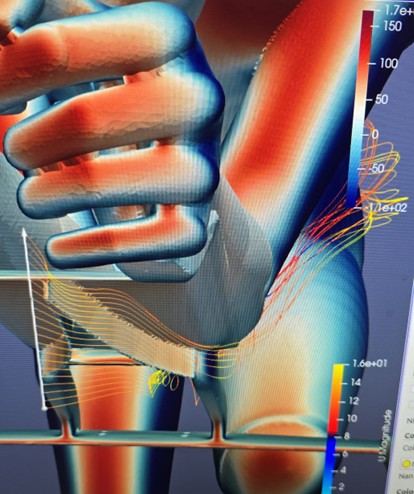
Trevor raced with this new bar at Eagleman 70.3, taking 2nd behind Sam Long who is using a mono aerobar made by Harry of Evolve. Prior to the race, IRONMAN officials reviewed this Speedbar | VeloVetta aerobar we made for Trevor and they gave their blessing for legality. IRONMAN stated that they appreciated this bar being a commercially available product and not something glued/taped together in a garage. Trevor plans to race on these bars at Boulder 70.3 this weekend to see if he can repeat his win from last year where he averaged over 30mph on the bike course.
This project shows how unintuitive aerodynamics can be and how complicated the interplay of physics, the human body, and the rules of sport can make decision making for professional and amateur athletes alike. These complications ensure that we will always have uncertainties about the best gear, best strategies, and best setups that we can debate with our friends. As a bike nerd, I enjoy seeking out answers, but I’m also glad that we will never have all the answers. There will always be an aspect of mystery and awe surrounding the incredible performances we see on the road.
Tags:
AerodynamicsGearSpeedbarTrevor FoleyVeloVettaWoveContinue the discussion at forum.slowtwitch.com
55 more replies




Great article.
How do you determine if these bars meet ISO 4210-5:2015 or other safety standard or testing to assure they are ‘safe’?
This is really a more general question for all these integrated set ups.
Or is this not applicable?
Ironman Rules:
5.03 (h) All aspects of the bicycle must be safe to the rider and to other athletes in the Race. Minimum safety standards include, but are not limited to, meeting or exceeding the standards of a reputable safety standards organization (such as CPSC, ISO, or other equally reputable safety standards organizations), properly glued and sealed tires, tight headset and handlebars, and true wheels;
Is there a valid response to the assertion that these ‘strakes’ which “manages the direction of the airflow downstream of the bar” and are (quote from IM Rules para on ‘fairings’) “added . . . to the structure with the intent to reduce (or having the effect of reducing) resistance to air penetration”?
“Provid[ing] some structural integrity” - just a little bit? Wouldn’t a sensible and simple (if drag-enhancing) engineering solution to assure “structural integrity” be to beef up the “somewhat flimsy carbon connecting plate”?
It’s a fairing. If people already use the bars “safely” on UCI teams this clearly is just pushing triathlon rules. Sure it’s great. But it’s a fairing. You can’t drink from it or store things in it.
Those huge molded together bars triathletes also use are pushing it a bit. The ones that they put carbon between the bars like people used to use electric tape for.
This is basically the same thing as the fairing you see each side under a semi truck trailer to manage airflow.
I love this last paragraph!
Which brings up a question : how was this validated in the field ?
Interesting, are you willing to share the results of the testing in the tunnel and/or outside aerotesting to see what effect wind/yaw has effect on this and how much cda gain you had?
Jeroen
I only did CFD modelling with this design, no wind tunnel or outdoor testing was performed. Maybe Trevor will choose to do that in the future, im not sure.
Ironman applies aero rules in a pretty opaque way. If this bar runs afoul of the rules, so would most aero helmets. Wheel disc covers would be illegal. Many aero crank sets would be illegal. Some wheels would also be illegal. When we made the bar we were not sure if it would be allowed or not. At Eagleman Trevor brought his old bars along just in case. When the officials inspected the bar they deemed it legal. Thats the only response i can have about that rule.
Good question, but at this time, there is no ISO testing for aerobars that I am aware of. I can imagine a test protocol and think it would be great to require.
What I do see is a lot of aerobars of all types bouncing up and down quite a bit over bumpy roads. These don’t do that from what I’ve seen.
So it is more guessing that it might be faster then there is actual ‘proof’ it is faster in different real life conditions.
To be honest that is a bit dissapointing as it is fairly easy to test stuff these days.
Unless it is a trevor-only thing and will not be marketed to consumers.
Jeroen
A well executed CFD model is significantly better than guessing. That’s why it’s used extensively in aircraft design, engine design, wildfire modelling and a host of other things where lives and a whole lot of money are on the line. “Proof” that its faster - i.e. irrefutable data - is awfully difficult to get in any human cyclist system, even with a wind tunnel. Good anecdotes are about as good as anyone ever gets.
It’s also worth noting that the aero testing that we do for Trevor is for him alone and the results are kept private, as is the case for the aero testing that nearly all athletes do. I think a company making their CFD data public, as in this article, is pretty good.
First of all that response is ‘whataboutery’ (helmets/wheels/cranks). The excellent aspect is that helmets and wheels are specifically dealt with in the IM Rules: the very opposite of “opaque”.
On what grounds were you unsure that this bar might “[not] be allowed”?
I appreciate you may not want to risk "respon[ding to questions] about that rule.
USAT officials deemed it legal. Come to Germany and try your luck with the DTU ‘enthusiasts’.
Wheel and helmet rules are clear. Nevertheless I believe the Kona (and optional) prohibition of disc wheels and what depth of rim constitutes a disc wheel (eg >100mm) needs gripping:
5.02 (a) Wheels
(i) The front wheel must be of spoke construction (aero rim with spokes is permitted) and must not be solid; (DSQ)
(ii) The rear wheel may be either spoke or solid construction (disc wheel). Wheel
covers are permitted only on the rear wheel. For reasons of safety, solid (disc) rear wheels are prohibited at the IRONMAN World Championship - Kona; (DSQ)
(iii) Wheels of spoke construction may consist of an aero rim with spokes (spokes may be bladed, round, flattened, or oval);
(b) Helmets
(i) Helmets must be approved by a national accredited testing authority and such authority must be recognized by the World Triathlon and the relevant National Federation; (DSQ)
I don’t think it is.
There is a rule saying no fairings. But then there are further rules that say, ‘but these are the fairings that are allowed’
That’s just poor rule writing. They can say, fairings are only allowed if preapproved, and below is a list of the fairings we allow, which include wheels, helmet, frame tubing, within particular guidelines.
But to say no fairings but then allow fairings because they piled on 20 pounds of additional written rules is the error in logic.
Kahneman in his book, Noise, writes about how rules can get made to be ‘noisy’. This is an example of that type of noise.
Whataboutery is problematic when you’re talking aboit objectively bad things. John Doe injured someone and argues he should not be held accountable because somone else got away with something similar.
In discussing whether a compnent falls within a set of rules, whatboutery is useful to understand the context in which the rule is interpreted.
And I guess we’ve just seen with hydrationgate an example of that. Except the rules themselves aren’t ‘noisy’: the interpretation doc is (as amended as amended eff today).
Btw, I think Foley’s new bars look excellent and he rode well at Eagleman. Assume IMLP for the full 4 hour test.
We’ll get a good look at 40 of the top sets of Pro bars in a few hours at Locarno Beach.
Is someone (Speedbar, Wove, you…) making this commercially available ?